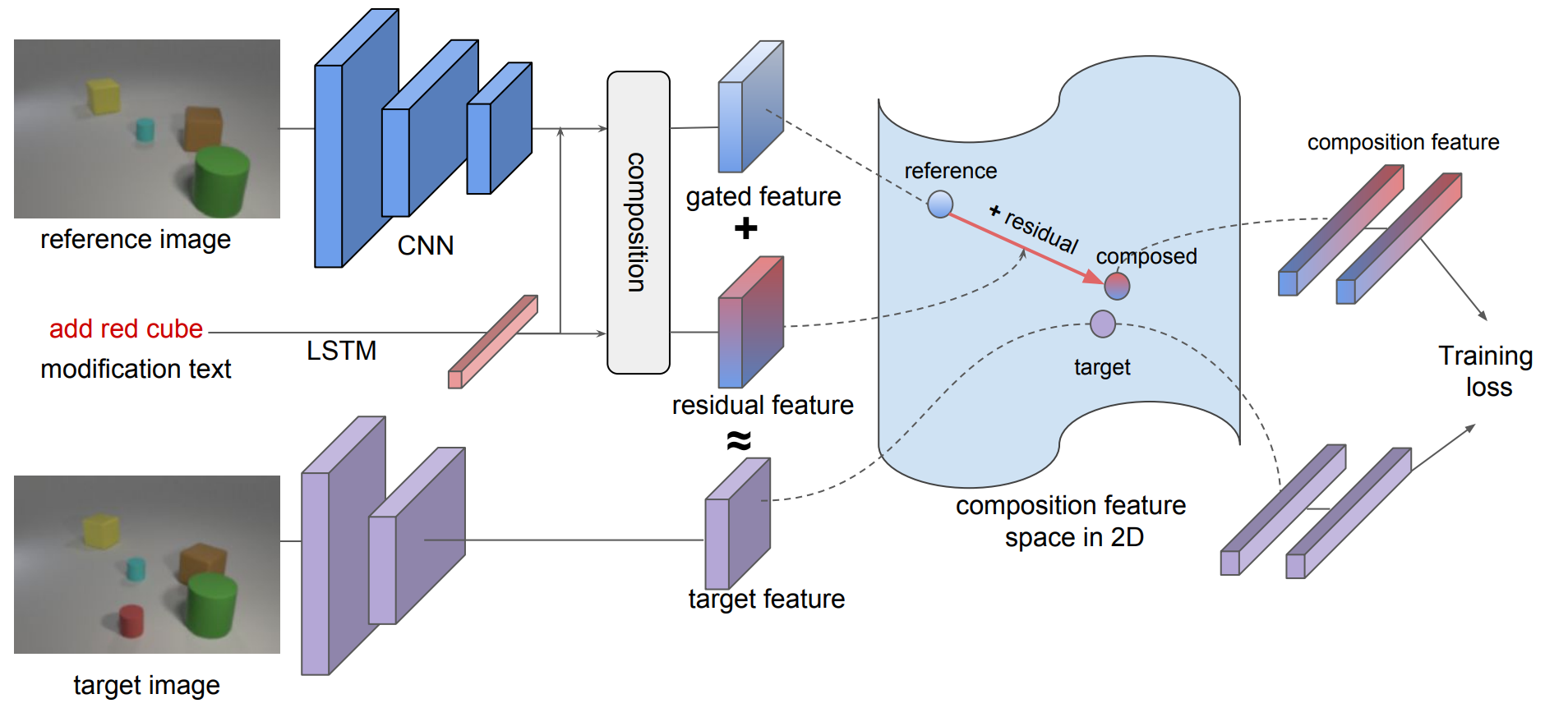google / Tirg
Programming Languages
Composing Text and Image for Image Retrieval
This is the code for the paper:
Composing Text and Image for Image Retrieval - An Empirical Odyssey
Nam Vo, Lu Jiang, Chen Sun, Kevin Murphy, Li-Jia Li, Li Fei-Fei, James Hays
CVPR 2019.
Please note that this is not an officially supported Google product. And this is the reproduced, not the original code.
If you find this code useful in your research then please cite
@inproceedings{vo2019composing,
title={Composing Text and Image for Image Retrieval-An Empirical Odyssey},
author={Vo, Nam and Jiang, Lu and Sun, Chen and Murphy, Kevin and Li, Li-Jia and Fei-Fei, Li and Hays, James},
booktitle={CVPR},
year={2019}
}
Introduction
In this paper, we study the task of image retrieval, where the input query is specified in the form of an image plus some text that describes desired modifications to the input image.
We propose a new way to combine image and text using TIRG function for the retrieval task. We show this outperforms existing approaches on different datasets.
Setup
- torchvision
- pytorch
- numpy
- tqdm
- tensorboardX
Running Models
-
main.py: driver script to run training/testing -
datasets.py: Dataset classes for loading images & generate training retrieval queries -
text_model.py: LSTM model to extract text features -
img_text_composition_models.py: various image text compostion models (described in the paper) -
torch_function.py: contains soft triplet loss function and feature normalization function -
test_retrieval.py: functions to perform retrieval test and compute recall performance
CSS3D dataset
Download the dataset from this external website.
Make sure the dataset include these files:
<dataset_path>/css_toy_dataset_novel2_small.dup.npy
<dataset_path>/images/*.png
To run our training & testing:
python main.py --dataset=css3d --dataset_path=./CSSDataset --num_iters=160000 \
--model=tirg --loss=soft_triplet --comment=css3d_tirg
python main.py --dataset=css3d --dataset_path=./CSSDataset --num_iters=160000 \
--model=tirg_lastconv --loss=soft_triplet --comment=css3d_tirgconv
The first command apply TIRG to the fully connected layer and the second applies it to the last conv layer. To run the baseline:
python main.py --dataset=css3d --dataset_path=./CSSDataset --num_iters=160000 \
--model=concat --loss=soft_triplet --comment=css3d_concat
MITStates dataset
Download the dataset from this external website.
Make sure the dataset include these files:
<dataset_path>/images/<adj noun>/*.jpg
For training & testing:
python main.py --dataset=mitstates --dataset_path=./mitstates \
--num_iters=160000 --model=concat --loss=soft_triplet \
--learning_rate_decay_frequency=50000 --num_iters=160000 --weight_decay=5e-5 \
--comment=mitstates_concat
python main.py --dataset=mitstates --dataset_path=./mitstates \
--num_iters=160000 --model=tirg --loss=soft_triplet \
--learning_rate_decay_frequency=50000 --num_iters=160000 --weight_decay=5e-5 \
--comment=mitstates_tirg
Fashion200k dataset
Download the dataset from this external website Download our generated test_queries.txt from here.
Make sure the dataset include these files:
<dataset_path>/labels/*.txt
<dataset_path>/women/<category>/<caption>/<id>/*.jpeg
<dataset_path>/test_queries.txt`
Run training & testing:
python main.py --dataset=fashion200k --dataset_path=./Fashion200k \
--num_iters=160000 --model=concat --loss=batch_based_classification \
--learning_rate_decay_frequency=50000 --comment=f200k_concat
python main.py --dataset=fashion200k --dataset_path=./Fashion200k \
--num_iters=160000 --model=tirg --loss=batch_based_classification \
--learning_rate_decay_frequency=50000 --comment=f200k_tirg
Pretrained Models:
Our pretrained models can be downloaded below. You can find our best single model accuracy: The numbers are slightly different from the ones reported in the paper due to the re-implementation.
- CSS Model: 0.760
- Fashion200k Model: 0.161
- MITStates Model: 0.132
Notes:
All log files will be saved at ./runs/<timestamp><comment>.
Monitor with tensorboard (training loss, training retrieval performance, testing retrieval performance):
tensorboard --logdir ./runs/ --port 8888
Pytorch's data loader might consume a lot of memory, if that's an issue add --loader_num_workers=0 to disable loading data in parallel.


